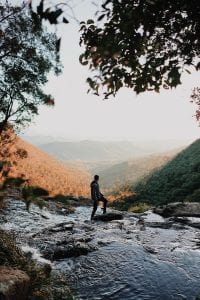Ecotourism, National Parks, Nature Refuges, Private Reserves, State Forests, Uncategorized
Let’s Talk Ecotourism – Part II
In October last year, NPAQ organised a seminar in Brisbane to discuss an important issue: the pros and cons of ecotourism in national parks.
In the last edition we caught up with two of the speakers and now we present the views of the other two speakers to get their perspectives in more detail.
David Edwards is the Projects Chief Executive at the Queensland Department of Innovation and Tourism Industry Development.
What is your view on ecotourism infrastructure in national parks?
I’m very supportive of ecotourism infrastructure and adventure and nature-based tourism experiences in national parks as long as it’s delivered responsibly and sustainably. I’ve travelled around New Zealand and Tasmania to look at best-practice and there are great examples of government, the private sector and local communities working together to create and showcase unique ecotourism experiences.
This is the approach we’re taking with the Queensland Ecotourism Trails program which focuses on three key pillars: protecting culture, preserving and presenting natural assets and future-proofing regional communities. For a proposal to be considered however, it must be delivered and operated in-accordance with strict environmental legislation, regulations and frameworks. Any facilities in parks must be located, designed and managed sensitively and sustainably to ensure compatibility with the area’s natural and cultural values.

Do you see ecotourism ventures as likely to benefit the ecological values of national parks?
Of course. By better presenting, protecting and promoting the ecological values of national parks, we’ll be able to better support the conservation of these areas. Using a collaborative model with Governments, Traditional Owners, local communities and the private sector, we’ll create genuine ecotourism experiences and unlock new income streams for the preservation and management of parks. As always, a balanced approach between sustainable development and conservation is essential. Ecotourism operations in parks will only be permitted where there is a clear understanding of how the park functions as an ecosystem, and where it can be shown that the sites’ cultural and heritage values can be conserved. It’s been fantastic to see Traditional Owners on country offering knowledge and skills to help with the parks’ protection. Through the collaborative approach we have established, we are all gaining a far better understanding of Traditional Owners’ special cultural places and the strong linkages there are between cultural heritage and biodiversity.
Ralf Buckley is the International Chair in Ecotourism Research (Emeritus) at Griffith University. Here is what he had to say.
Queensland escaped the 2019/20 summer bushfire season comparatively unscathed. NSW did not. Immediately following the fires in NSW national parks, tourism enterprises throughout much of regional NSW reported 60% loss of business. The roads were open, the tourism facilities intact, but the attractions – views, vegetation and wildlife – were less attractive.
Effectively, the fires created a giant natural experiment, showing that parks support tourism outside their boundaries. This is not new: “benefits beyond boundaries” is a long-established concept in parks economics. It was a very practical demonstration for the regional tourism industry, however, just how much their routine customer base is connected to park visitation.
To reiterate: the tourism industry makes much more money from large numbers of people traveling to visit public national parks cheaply or free, than from exclusive private tourism operations inside the parks themselves. Much more. And via businesses that already exist. If governments want to boost tourism, they should increase parks agency budgets directl.
Private tourism businesses inside parks sell exclusivity. This discourages public visitation to those areas. That reduces total visitor numbers, which reduces client numbers for tourism businesses outside the parks. Private tourism developments inside parks thus decrease the total economic contribution of parks to the tourism sector.
The Queensland Ecotourism Trails (QET) strategy adopts approaches attempted in the 1990s, when tourism lobbyists pushed the language of “partnership”, to persuade parks agencies to grant them preferential development rights. This is why QET is driven by QDITID, not QDES.
Over the past 30 years, parks agencies worldwide have tested a wide variety of arrangements with private tourism entrepreneurs, summarized at the NPAQ seminar. This global practical experience shows that with few exceptions, these approaches have created environmental impacts, social inequities, and economic costs, for taxpayer-funded national parks.
There are a few private tourism companies worldwide, that do contribute to conservation. They do so, however, under very different arrangements from those proposed under the QET. QET could adopt the most successful features of each. But it does not: rather the reverse.
It is now 2020. The world has recognized that people need nature not only for ecosystem services, but to maintain individual mental health. Human societies are increasingly busy and urbanized, with less exposure to nature, and higher costs of poor mental health. For immediate human health as well as long-term biodiversity conservation, we need more parks, better protected, and more accessible.
Low-impact tracks and trails, lookouts and toilets, signs and campsites all contribute to this goal; but only if they are equally and cheaply available to all park visitors. Privately owned and preferentially accessible tourist facilities and infrastructure inside parks, as proposed in the QET, detract from this goal.
Currently, track maintenance in national parks in Queensland focuses heavily on sections immediately adjacent to car parks, because of concerns over potential liability for poorly prepared and inexperienced tourists. There are many older tracks and trails that are completely abandoned. They are no longer shown on parks maps, and only bushwalking clubs and local residents know that they exist.
Lamington National Park, an internationally famous World Heritage area close to Queensland’s largest population centres, provides a prime example. There are many abandoned trails, well constructed 80 years ago, with stone steps and supporting walls that still survive in places. Even thirty years ago, these tracks were still in reasonable condition, and used regularly by international tourists as well as locals. Now, however, they are tumbledown and overgrown, hard to find and slow to traverse.
If Queensland is serious about an economic boost to tourism through trails in parks, then restoring existing trails should be the top priority. More trails means more visitors, and more visitors bring more tourist expenditure along access roads and gateway towns. That means a substantial boost in the Queensland Parks budget, for trail maintenance and repair specifically.
But perhaps the real issue was well stated many years ago by cartoonist Patrick Cook, in regard to government funding of railway tracks: “Both ends must be in marginal electorates.”



I am strongly opposed to privitising of our National Heritage. Why cannot these who are desirous of bringing such tourists build their facilities near but outside National Parks. I will not support and such proposals.